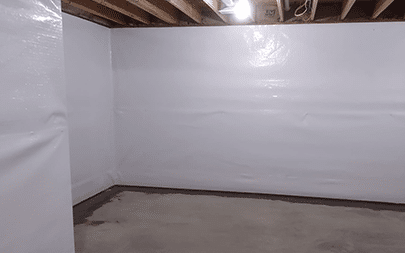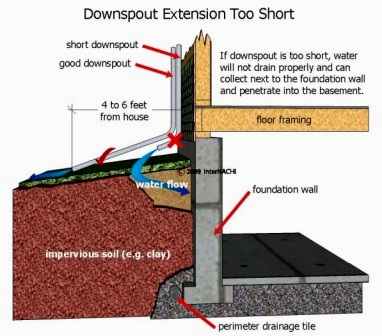How Basement Waterproofing Works: A Comprehensive Guide for Your Home
Basement waterproofing is crucial for protecting homes from water damage. Different approaches exist to resolve wetness problems, each customized to details causes. House owners have to understand these alternatives to pick the very best service for their requirements - Basement Waterproofing. The efficiency of these approaches counts on the right products and strategies. What are one of the most usual approaches, and how can they be executed successfully? This overview will discover these critical facets
Understanding the Reasons of Cellar Wetness
Although cellars are often designed to be practical and completely dry areas, they can come down with dampness due to various factors. One key cause is bad drainage around the structure, which can result in water pooling and infiltration. In addition, hefty rains or fast snowmelt can overwhelm drain systems, worsening moisture problems. Another substantial element is the all-natural humidity present in the ground, which can permeate via walls and floorings, particularly in older homes with less effective barriers. Splits in the foundation may additionally enable water breach, especially throughout periods of hefty precipitation. In addition, plumbing leakages within the cellar can add to moisture accumulation, producing an atmosphere helpful to mold and mildew growth. Lastly, poor ventilation can trap humidity, getting worse the overall wetness problem. Comprehending these reasons is crucial for house owners looking for effective services to stop basement moisture issues.
Kinds Of Basement Waterproofing Methods
Basement waterproofing approaches are crucial for protecting homes from moisture damage and preserving a secure living environment. These techniques can be broadly classified right into exterior and interior remedies. Interior waterproofing generally involves the setup of drain systems, sump pumps, and vapor barriers. These systems function to draw away water far from the basement and prevent dampness from penetrating via the wall surfaces or floor.On the various other hand, outside waterproofing concentrates on stopping water from entering the home in the top place. This can include excavation around the structure, using waterproof layers, and installing water drainage ceramic tiles to reroute water far from the framework. Furthermore, some house owners may choose a combination of both interior and exterior approaches to assure detailed defense. Inevitably, the choice of waterproofing approach depends upon the particular problems of the home and the level of moisture existing in the basement.
Products Made Use Of in Waterproofing Solutions

Various materials are used in waterproofing options to boost the effectiveness of both external and interior techniques. Typically utilized materials consist of liquid membrane layers, which produce a seamless barrier against moisture. These membrane layers are typically made from polyurethane or rubberized asphalt, using flexibility and resilience. Furthermore, cementitious waterproofing products are prominent for their convenience of application and strong bond to surfaces.For outside applications, materials such as water drainage boards and geotextiles work in redirecting water far from foundations. Crushed stone and gravel are likewise used in drain systems, advertising correct water circulation and minimizing stress buildup. Sometimes, specialized finishings and sealers, like silicone or epoxy, are used to supply additional defense against water seepage. With each other, these products play a necessary function in ensuring that a basement stays dry and secured from water damages.
Steps to Water-proof Your Basement
Waterproofing a basement includes an organized strategy to successfully stop water intrusion and damages. The very first step is to inspect the outside of the home, checking for fractures or spaces in the foundation. These need to be secured with an ideal waterproof sealant. Next, verify that downspouts and rain gutters are functioning appropriately and directing water away from the foundation.After dealing with exterior concerns, the interior should be analyzed. Installing a waterproof membrane on basement wall surfaces can supply added security. Water Solutions. It's likewise suggested to implement a sump pump system to handle any kind of water accumulation.Finally, rating the landscape around the home can assist direct water away from the structure, more decreasing the risk of water infiltration. By complying with these actions vigilantly, house owners can produce a robust defense against cellar flooding and dampness issues
Upkeep and Prevention Tips for a Dry Basement
Normal upkeep and proactive measures are key to ensuring a completely dry basement long after preliminary waterproofing initiatives. Property owners must consistently check gutters and downspouts, ensuring they direct water away from the structure. It is important to maintain these free from particles to stop overflow. Furthermore, preserving correct grading around the home assists network water away from the structure.Checking for cracks in floors or walls is important, as these can enable dampness seepage. Any type of identified cracks need to be immediately secured with suitable materials. Setting up a sump pump can supply added defense against flooding.Humidity degrees in the basement should likewise be kept track of, as high moisture can lead to mold growth. Using a dehumidifier can help preserve a comfortable atmosphere. Ensuring correct air flow in the basement aids in reducing moisture accumulation, preserving the stability of the waterproofing system over time.
Regularly Asked Concerns
How Lengthy Does Basement Waterproofing Commonly Last?
The durability of cellar waterproofing often varies based on products and installation high quality. Usually, it can last from 5 to ten years, with some systems possibly enduring click for more longer if appropriately kept and kept an eye on over time.
Can I Waterproof My Basement Myself?
The private considered whether to water-proof their cellar independently. While DIY choices exist, they call for expertise of materials and methods. Professional services guarantee efficient results, usually exceeding the possible risks and difficulties connected with self-installation.

What Are the Indications of Inadequate Waterproofing?
Indicators of inadequate waterproofing include consistent dampness, mold development, moldy odors, peeling off paint, and water stains on floorings or wall surfaces. House owners ought to attend to these concerns promptly to avoid more damages and keep a healthy living environment.

Does Cellar Waterproofing Increase Home Worth?
Cellar waterproofing can improve a home's worth by avoiding water damages and improving livable news space. Prospective customers commonly prioritize dry cellars, making waterproofing an important financial investment that adds to general residential property charm and marketability.
Just How Much Does Cellar Waterproofing Cost usually?
The typical cost of cellar waterproofing generally ranges from $1,500 to $5,000, differing based upon factors such as job dimension, method used, and regional market problems. Homeowners need to acquire several quotes for exact price quotes. Cellar waterproofing is essential for securing homes from water damages. Basement waterproofing methods are vital for securing homes from moisture damages and preserving a safe living atmosphere. These systems work to try this website draw away water away from the cellar and avoid moisture from penetrating through the walls or floor.On the other hand, exterior waterproofing concentrates on stopping water from getting in the home in the initial location. The longevity of basement waterproofing usually varies based on materials and setup quality. Cellar waterproofing can improve a home's worth by preventing water damages and boosting habitable space.